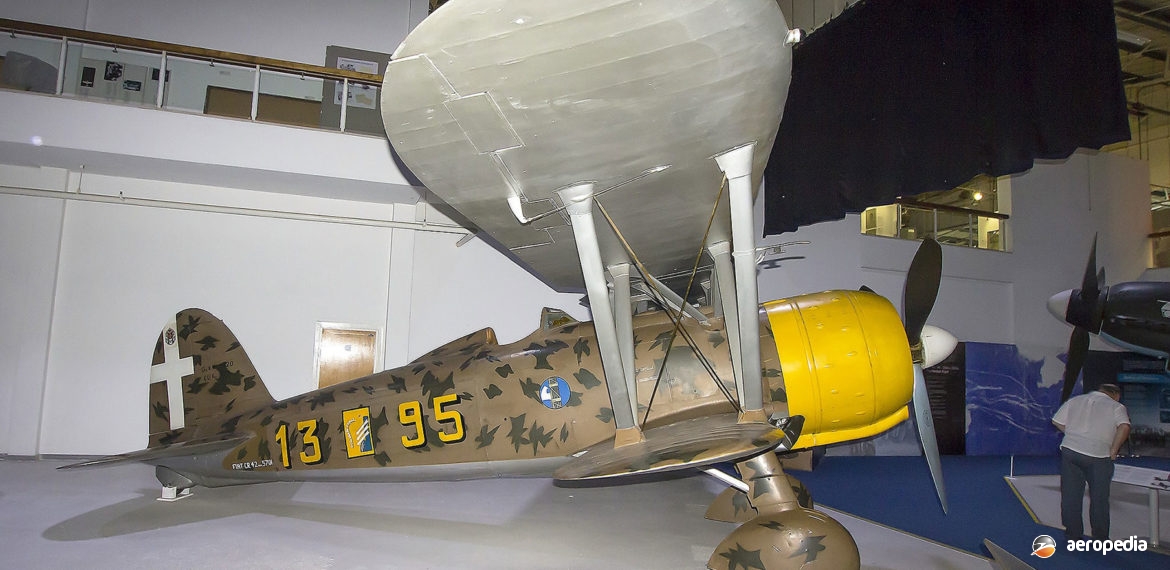Photograph:
Fiat CR.42 Falco MM5701 at the RAF Museum at Hendon, United Kingdom in July 2012 (Steven Veigel)
Country of origin:
Italy
Description:
Single-seat fighter biplane
Power Plant:
One 627 kw (840 hp) Fiat A.74 RIC.38 fourteen-cylinder two-row air-cooled radial engine
Specifications:
- Wingspan: 9.7 m (31 ft 9⅞ in)
- Length: 8.27 m (27 ft 1⅔ in)
- Height: 3.59 m (11 ft 9⅓ in)
- Wing area: 22.4 m² (241.11 sq ft)
- Max speed at sea level: 342 km/h (212 mph)
- Max speed at 3,000 m (9,840 ft): 397 km/h (247 mph)
- Time to climb to 5,000 m (16,405 ft): 7.33 mins /li>
- Service ceiling: 10,200 m (33,465 ft)
- Range at 5,500 m (18,045 ft) at 380 km/h (236 mph): 775 km (481 miles)
- Empty weight: 1,782 kg (3,929 lb)
- Loaded weight: 2,295 kg (5,059 lb)
Armament:
Two 12.7 mm (0.50 in) machine guns mounted in forward fuselage
History:
The CR.42 was designed by Celestino Rosatelli and was a development of the Fiat CR.32 fighter, and the experimental Fiat CR.41 of 1936. It was the last single-seat biplane fighter built by any of the combatants for World War II.
The prototype flew for the first time in 1939 and entered production soon thereafter. First production aircraft went to the Hungarian Air Force, and these were used for home defence. This order was followed by the Belgian Air Force for 34 aircraft but a number of the latter were destroyed by German forces when Belgium was over-run, 13 being destroyed in the first Luftwaffe aerial attack by Junkers Ju 87s. The type was used by the Regia Aeronautica in attacks on the British Isles in November 1940 and later the type was used extensively in the Mediterranean and North African campaigns.
The Fiat CR.42 employed Warren-type interplane bracing and featured a number of technical improvements, making use of materials such as manganese and molybdenum steel. The fuselage was welded steel-tube faired to an oval section and covered with metal panels forward and fabric aft. The unequal-span wings were rigidly-braced and were of light alloy and steel construction with fabric covering. It had a fixed tailwheel undercarriage.
First combat of the type was in June 1940 when Italian Air Force aircraft met French Armee de l’Air Dewoitine D.520s. They were also briefly used in attacks on the British Isles but did not fare well and the CR.42 was subsequently used in the fighter bomber role, carrying two 100 kg (220 lb) bombs on underwing racks. A total of 1,781 examples was completed.
A total of 72 was supplied to the Swedish Flygvapnet in 1940, these being fitted with Bristol Mercury VIII engines built in Sweden by Nohab.
In 1941 the CR.42B appeared with a Daimler Benz DB 601 twelve-cylinder VEE engine but by this time the CR.42 had passed its use-by date. Its main fame came about from its use in North Africa.
Three examples are known to have survived: one (MM5701), which was tested by the Royal Aeronautical Establishment (RAE) at Farnborough, which was allotted the British serial BT474, has been placed on display at the RAF Museum at Hendon; another which has been restored in Italy for the Italian Air Force Museum; and another which has been under construction to fly in Italy.
Two examples of the CR.42 are known to have been captured and operated by No 3 Squadron, RAAF, in Libya in North Africa during 1943. The location and return to airworthiness of Axis aircraft was one of the pastimes of members of the RAF, RAAF and SAAF in North Africa during the war.
One example (serial 7-70) was located at Martuba in Libya in January 1941. It was given the No 3 Squadron Code OK-Fs. It was flown at Benina in Libya in March 1941 after being serviced but was later destroyed on 4 April 1941 at Gotes-Sultan landing ground.
The second aircraft was given the Squadron Code OK-B and was allotted the Australian serial A.421. It seems that at some stage plans were put in place to return this aircraft to Australia as a war trophy. The serial allotted comprised A (for Australia), 42 from the designation CR.42, and No 1 for the first to be shipped out. In the event the plan was not able to be put in place and eventually the aircraft was destroyed to prevent it falling into enemy hands.

